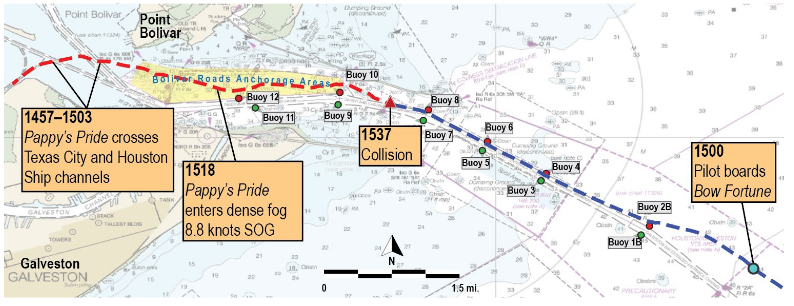(WASHINGTON) — The National Transportation Safety Board (NTSB) issued Marine Accident Brief 21/21 on Thursday for its investigation of the Jan. 14, 2020, fatal collision of the tanker Bow Fortune and commercial fishing vessel Pappy’s Pride near Galveston, Texas.
Bow Fortune was transiting inbound in the Outer Bar Channel while Pappy’s Pride was transiting outbound. The two vessels collided in dense fog and the fishing vessel capsized and sank. Three of the four crewmembers aboard the fishing vessel died. One crewmember sustained serious injury. There were no injuries to the pilot or crew of 28 on board Bow Fortune. A surface sheen of diesel was reported. The fishing vessel was a total loss valued at $575,000.

Prior to the collision, the pilot of Bow Fortune used VHF radio to hail Pappy’s Pride three times and Bow Fortune sounded two danger signals. Pappy’s Pride’s captain had radar, automatic radar plotting aid and electronic charts on board capable of showing the automatic identification system (AIS) information of nearby vessels. The Pappy’s Pride AIS history showed that the captain made multiple course changes, indicating he was actively steering; however, Pappy’s Pride did not reply to any of the radio calls or danger signals.
Investigators determined the probable cause of the collision was the captain of Pappy’s Pride’s outbound course toward the ship channel, which created a close quarters situation in restricted visibility. Contributing to the collision was the lack of communication from the captain of Pappy’s Pride.
“Early communication can be an effective measure in averting close quarters situations,” the NTSB report said. “The use of VHF radio can help to dispel assumptions and provide operators with the information needed to better assess each vessel’s intentions.”
